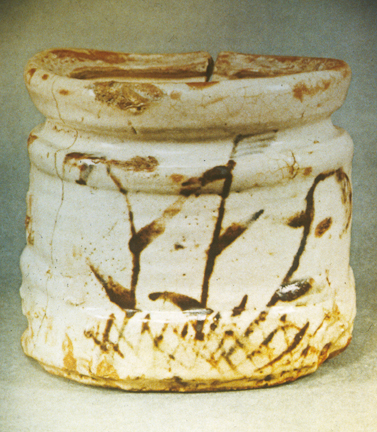During the Momoyama, often called the 'Golden Age of Japanese Ceramics,' the kilns at Seto gradually declined in production to be replaced by kilns at nearby Mino. At Mino, the classic tea ceremony wares Shino and Oribe were produced. There are several recognized types of Shino, but the most common is what is called Painted Shino, seen in this example. This tea ceremony water pot (mizusashi) would have had a lid made of wood that would nestle in the lip of the jar. Lids were made of wood so that the sound of the lid being replaced would not be loud or jarring, and spoil the meditative atmosphere of the tea room. Shino ware is unique in the earliest use of an opaque, white glaze in Japan. Shino glaze is very simply made from only a few raw earth minerals, and often imperfectly melts. Crazing is common, as is crawling, the technical term for a glaze that separates in melting, leaving patches of unglazed clay next to pools of glaze. Pinholing is also often seen, the result of escaping gases being trapped in the glaze. The resulting surface, with all its imperfections, is a major part of the interest of Shino ware. It is beautifully imperfect. There are two suggested origins of the name Shino: in Japanese, Shiro means 'white,' like the color of the glaze; or possibly that the name derives from Shino Muenobu, the founder of the school of incense appreciation.
This particular example, called Furugishi, or 'Deserted Strand,' is an example of the mizusashi form especially loved by tea ceremony devotees. The design painted on this piece in iron oxide on the opaque white glaze is depiction of reeds blown in the wind on a deserted strand of beach. Shino ware that exhibits the quality of 'hiro,' literally, 'fire color' is especially desired. This refers to the areas where the white glaze turns reddish brown at edges and rims, as seen here. Shino clay is a coarse, sandy stoneware that also adds to the rugged attraction of this ware. This piece is registered as a 'national cultural treasure.'
During the Momoyama, feudal lords competed to build magnificent castles and residences, and to show their sophistication, adopted the tea ceremony, previously practiced by just the intelligentsia and the aesthetes. The tea ceremony is still practiced today, and is called cha-no-yu, the way of tea.

Painted Shino Water Pot (Mizusashi), Stoneware with iron oxide decoration
Japan, Momoyama Period, 1568-1615 CE


